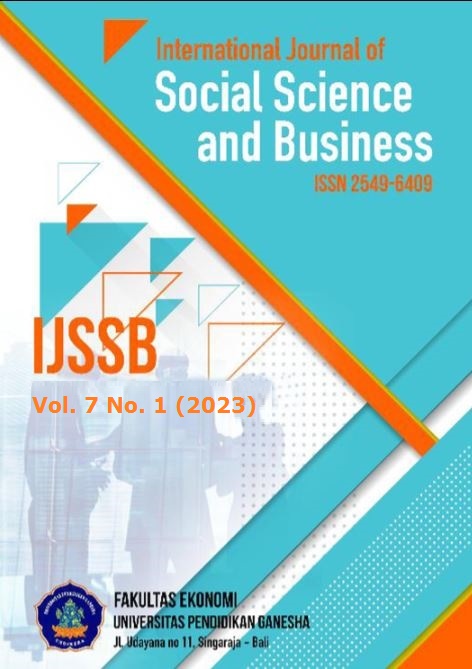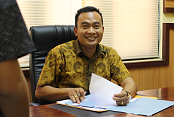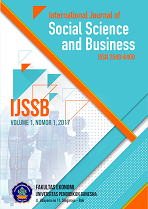The Role of International Organizations and the Indonesian Government in Eradicating the Transnational Crime of Modern Child Slavery
DOI:
https://doi.org/10.23887/ijssb.v7i1.45789Keywords:
Human trafficking, Child trafficking, Transnational crime, Modern SlaveryAbstract
Every year, a billion dollars is made in profit from human trafficking, carried out at the expense of thousands of innocent victims who are exploited by traffickers. International organizations and national governments must collaborate to solve this problem. This normative study aims to explore the role of international organizations and the Indonesian government in the fight against child trafficking, with the goal of eradicating the practice. After analyzing through prescriptive analysis, the results conclude that the International Organization has done everything possible to abolish child trafficking, including establishing comprehensive legislation through the UN Palermo Protocol and enacting Resolution 70/1, according to the research findings. This is true not only at the highest levels of the UN but also at the lowest levels of the ASEAN. The Indonesian government is still not seen as optimal in preventing child trafficking. According to the findings of this study, the government should take a more proactive approach to eradicate child trafficking by educating the public, harshly punishing perpetrators, and providing protection for victims. And these results are obtained from secondary data sources that have been collected, through the library search method, and analyzed.
References
Al-Assaf, S. A. (2021). Protection of victims of human trafficking in the Jordanian law: A comparative study with the UK Modern Slavery Act 2015. Cogent Social Sciences, 7(1). https://doi.org/10.1080/23311886.2021.1948185. DOI: https://doi.org/10.1080/23311886.2021.1948185
Anderson, G. D. (2021). Child sexual abuse prevention policy: An analysis of Erin’s law. Social Work in Public Health, 29(3), 196–206. https://doi.org/10.1080/19371918.2013.776321. DOI: https://doi.org/10.1080/19371918.2013.776321
Bah, Y. M., Artaria, M. D., & Suen, M. W. (2022). Child Sex Tourism: A Case Study in Surabaya, Indonesia. Journal of Developing Societies, 38(1), 103–117. https://doi.org/10.1177/0169796X211068398. DOI: https://doi.org/10.1177/0169796X211068398
Bergmark, M., Bejerholm, U., & Markström, U. (2017). Policy changes in community mental health: Interventions and strategies used in Sweden over 20 years. Social Policy & Administration, 51(1), 95–113. https://doi.org/10.1111/spol.12175. DOI: https://doi.org/10.1111/spol.12175
Blazek, M., Esson, J., & Smith, D. P. (2019). Relational geographies of human trafficking: Inequality, manoeuvring and im/mobility across space and time. Transactions of the Institute of British Geographers, 44(1), 63–78. https://doi.org/10.1111/TRAN.12271. DOI: https://doi.org/10.1111/tran.12271
Brayley, H., & Cockbain, E. (2014). British Children Can Be Trafficked Too: Towards an Inclusive Definition of Internal Child Sex Trafficking. Child Abuse Review, 23(3), 171–184. https://doi.org/10.1002/CAR.2307. DOI: https://doi.org/10.1002/car.2307
Broad, R., & Turnbull, N. (2018). From Human Trafficking to Modern Slavery: The Development of Anti-Trafficking Policy in the UK. European Journal on Criminal Policy and Research, 25(2), 119–133. https://doi.org/10.1007/S10610-018-9375-4. DOI: https://doi.org/10.1007/s10610-018-9375-4
Bryant, K., & Landman, T. (2020). Combatting Human Trafficking since Palermo: What Do We Know about What Works? Journal of Human Trafficking, 6(2), 119–140. https://doi.org/10.1080/23322705.2020.1690097. DOI: https://doi.org/10.1080/23322705.2020.1690097
Budiani-Saberi, D., & Columb, S. (2013). A human rights approach to Human Trafficking for Organ Removal. Medicine, Health Care and Philosophy, 16(4), 897–914. https://doi.org/10.1007/S11019-013-9488-Y. DOI: https://doi.org/10.1007/s11019-013-9488-y
Chen, K. (2014). Human Security, Transnational Crime and Human Trafficking: Asian and Western Perspectives. Edited by Shiro Okubo and Louise Shelly. Journal of Refugee Studies, 27(2), 307–308. https://doi.org/10.1093/JRS/FEU006. DOI: https://doi.org/10.1093/jrs/feu006
Cockbain, E., & Bowers, K. (2019). Human trafficking for sex, labour and domestic servitude: how do key trafficking types compare and what are their predictors? Crime, Law and Social Change, 72(1), 9–34. https://doi.org/10.1007/S10611-019-09836-7/FIGURES/8. DOI: https://doi.org/10.1007/s10611-019-09836-7
Conradi, C. (2013). Child Trafficking, Child Soldiering: exploring the relationship between two ‘worst forms’ of child labour. Third World Quarterly, 34(7), 1209–1226. https://doi.org/10.1080/01436597.2013.824639. DOI: https://doi.org/10.1080/01436597.2013.824639
Cordisco Tsai, L., Lim, V., Nhanh, C., & Namy, S. (2022). “They Did Not Pay Attention or Want to Listen When We Spoke”: Women’s Experiences in a Trafficking-Specific Shelter in Cambodia: Affilia, 37(1), 151–168. https://doi.org/10.1177/0886109920984839. DOI: https://doi.org/10.1177/0886109920984839
Dando, C. J., Walsh, D., & Brierley, R. (2016). Perceptions of Psychological Coercion and Human Trafficking in the West Midlands of England: Beginning to Know the Unknown. PLOS ONE, 11(5), e0153263. https://doi.org/10.1371/JOURNAL.PONE.0153263. DOI: https://doi.org/10.1371/journal.pone.0153263
Davy, D. (2013). Responding to Child Sex Trafficking: Transnational Advocacy Networks in the Greater Mekong Subregion. Women & Criminal Justice, 23(4), 304–325. https://doi.org/10.1080/08974454.2013.821014. DOI: https://doi.org/10.1080/08974454.2013.821014
Dewata, M. F. N., & Achmad, Y. (2019). Dualisme Penelitian Hukum Normatif dan Empiris (Cetakan V) (Pustaka Pelajar (ed.)).
Greenbaum, V. J. (2017). Child sex trafficking in the United States: Challenges for the healthcare provider. PLOS Medicine, 14(11), e1002439. https://doi.org/10.1371/JOURNAL.PMED.1002439. DOI: https://doi.org/10.1371/journal.pmed.1002439
Hadjipanayis, A., Crawley, F. P., Stiris, T., Neubauer, D., & Michaud, P. A. (2018). Child trafficking in Europe: what is the paediatrician’s role? A statement by the European Academy of Paediatrics. European Journal of Pediatrics, 177, 1419–1423. https://doi.org/10.1007/S00431-018-3190-2. DOI: https://doi.org/10.1007/s00431-018-3190-2
Kiss, L., Pocock, N. S., Naisanguansri, V., Suos, S., Dickson, B., Thuy, D., Koehler, J., Sirisup, K., Pongrungsee, N., Nguyen, V. A., Borland, R., Dhavan, P., & Zimmerman, C. (2015). Health of men, women, and children in post-trafficking services in Cambodia, Thailand, and Vietnam: an observational cross-sectional study. The Lancet Global Health, 3(3), e154–e161. https://doi.org/10.1016/S2214-109X(15)70016-1. DOI: https://doi.org/10.1016/S2214-109X(15)70016-1
Kotiswaran, P. (2019). Trafficking: A Development Approach. Current Legal Problems, 72(1), 375–416. https://doi.org/10.1093/CLP/CUZ012. DOI: https://doi.org/10.1093/clp/cuz012
Loomba, A. P. S. (2017). Reconstructing lives: transformative services for human trafficking survivors. Journal of Services Marketing, 31(4–5), 373–384. https://doi.org/10.1108/JSM-06-2016-0228/FULL/XML. DOI: https://doi.org/10.1108/JSM-06-2016-0228
Mace, S. L., Venneberg, D. L., & Amell, J. W. (2012). Human Trafficking: Integrating Human Resource Development Toward a Solution. Advances in Developing Human Resources, 14(3), 333–344. https://doi.org/10.1177/1523422312446053. DOI: https://doi.org/10.1177/1523422312446053
Martinho, G., Gonçalves, M., & Matos, M. (2022). “It takes a community to save a child”: Child trafficking knowledge of the Portuguese community. Journal of Community Psychology, 50(2), 1028–1047. https://doi.org/10.1002/JCOP.22698. DOI: https://doi.org/10.1002/jcop.22698
Muraya, D. N., & Fry, D. (2016). Aftercare Services for Child Victims of Sex Trafficking: A Systematic Review of Policy and Practice. Trauma, Violence, and Abuse, 17(2), 204–220. https://doi.org/10.1177/1524838015584356. DOI: https://doi.org/10.1177/1524838015584356
Nichols, A. J. (2016). Sex trafficking in the United States: Theory, research, policy, and practice. Columbia University Press. DOI: https://doi.org/10.7312/nich17262
Ottisova, L., Smith, P., Shetty, H., Stahl, D., Downs, J., & Oram, S. (2018). Psychological consequences of child trafficking: An historical cohort study of trafficked children in contact with secondary mental health services. PLOS ONE, 13(3), e0192321. https://doi.org/10.1371/JOURNAL.PONE.0192321. DOI: https://doi.org/10.1371/journal.pone.0192321
Palmer, W., & Missbach, A. (2017). Trafficking within migrant smuggling operations: Are underage transporters ‘victims’ or ‘perpetrators’?: Asian and Pacific Migration Journal, 26(3), 287–307. https://doi.org/10.1177/0117196817726627. DOI: https://doi.org/10.1177/0117196817726627
Rashad, S. M. (2019). Child trafficking crime and means of fighting it: Egypt as a case study. Review of Economics and Political Science, 1(1). https://doi.org/10.1108/REPS-03-2019-0029. DOI: https://doi.org/10.1108/REPS-03-2019-0029
Saner, R., Yiu, L., & Rush, L. (2018). The measuring and monitoring of human trafficking. Public Administration and Policy, 21(2), 94–106. https://doi.org/10.1108/PAP-10-2018-011. DOI: https://doi.org/10.1108/PAP-10-2018-011
Schönhöfer, J. (2017). Political determinants of efforts to protect victims of human trafficking. Crime, Law and Social Change, 67(2), 153–185. https://doi.org/10.1007/S10611-016-9643-5/TABLES/6. DOI: https://doi.org/10.1007/s10611-016-9643-5
Sibarani, S. (2020). Policies Adopted by the Government of Indonesia in the Prevention of Trafficking in Persons (Human Trafficking). Advances in Social Science, Education and Humanities Research, 19–24. https://doi.org/10.2991/ASSEHR.K.201209.004. DOI: https://doi.org/10.2991/assehr.k.201209.004
Visser, A., Du Preez, P., & Simmonds, S. (2019). Reflections on Life Design Narrative Inquiry as a Methodology for Research With Child Sex Trafficking Survivors. International Journal of Qualitative Methods, 18, 1609406919857553. https://doi.org/10.1177/1609406919857553. DOI: https://doi.org/10.1177/1609406919857553
Wahyuningrum, Y. (2021). A decade of institutionalizing human rights in ASEAN: Progress and challenges. Journal of Human Rights, 20(2), 158–175. https://doi.org/10.1080/14754835.2021.1875811. DOI: https://doi.org/10.1080/14754835.2021.1875811
Weinrich, A. R. (2020). The Emerging Regional Citizenship Regime of the Association of Southeast Asian Nations: Journal of Current Southeast Asian Affairs, 40(2), 201–223. https://doi.org/10.1177/1868103420972415. DOI: https://doi.org/10.1177/1868103420972415
Weitzer, R. (2014). New Directions in Research on Human Trafficking. The ANNALS of the American Academy of Political and Social Science, 653(1), 6–24. https://doi.org/10.1177/0002716214521562. DOI: https://doi.org/10.1177/0002716214521562
Zimmerman, C., & Kiss, L. (2017). Human trafficking and exploitation: A global health concern. PLOS Medicine, 14(11), e1002437. https://doi.org/10.1371/Journal.PMED.1002437. DOI: https://doi.org/10.1371/journal.pmed.1002437
Downloads
Published
How to Cite
Issue
Section
License
Copyright (c) 2022 International Journal of Social Science and Business

This work is licensed under a Creative Commons Attribution-ShareAlike 4.0 International License.











